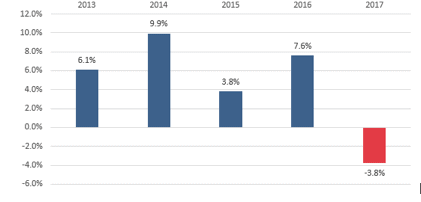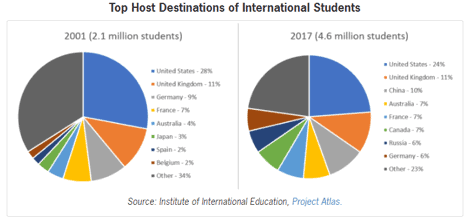May 25th, 2018

Every day, those of us who are in international education, especially, those of us working at institutions and organizations in the USA, hear nothing but negative news about the decline in the number of international students studying at our colleges and universities. Many of us anticipated that this was going to happen as soon as Donald Trump took office. Our concerns were confirmed with the first roll out of the travel ban in January 2018 which caused immediate confusion and havoc at our airports and borders. The anti-immigration sentiments and a general distaste for “internationalism” or “globalism” vocalized by the Trump administration has given many parents of potential international students pause and reason to consider another destination for their child’s study abroad experience.
We know that international students, as stated by Stuart Anderson states in his March 3, 2018 article in Forbes, have been “America’s golden goose” contributing billions of dollars ($39 billion to be exact) to the U.S. economy every year. In fact, it is these very dollars that have helped subsidize the education of U.S.(domestic) students and attract international talent to American tech companies who have been instrumental in innovations that make the U.S. the envy of the world.
Given the economic value of international students, it is baffling that the agenda of the Trump Presidency that ran on a platform to run the country as a business, is in fact hurting this revenue flow by driving away international students who had once hoped to study in the U.S.

Source: National Science Foundation, Science Engineering Indicators 2018.
In his article for Forbes, Mr. Anderson breaks down the various measures taken by the Trump Administration which have negatively impacted international student numbers which I will highlight below:
• Stricter guidelines to obtain H-1B visas, proposals to eliminate work authorization for the spouses of H1-B visa holders, and long waits to obtain employment-based green cards have led to a 21% drop in students from India enrolling in graduate level programs in computer science and engineering at U.S. institutions;
• Proposed restrictions on Optional Practical Training (OPT); the ability of international students to work after graduation, which allows for 12 months of work for students, especially those in STEM fields;
• Finally, individuals who previously worked for organizations or Senators with animus toward international students and employment-based immigration currently hold key positions dealing with immigration policy within the executive branch.
U.S. institutions of higher education are already feeling the sting. Sara Beverage with the Registrar’s Office at the University of Minnesota, Duluth (UMD), confirms that her institution has experienced a slight decrease in the international student numbers which she attributes to “recent federal policy changes and the way that the global community less favorable perceives the United States.”
Zepur Solakian, President of the Center for the Global Advancement of Community Colleges (CGACC), attributes the decline in international student numbers to a number of factors such as: “…the current political climate as messaged by the Trump administration, as well as the termination of the Saudi and Brazilian scholarship programs and the rise in global competition.”
This was echoed by Melissa Goodwin, Associate Director of Admissions at the University of Idaho. According to Ms. Goodwin: “Since 2014, we have experienced a general decline due to changes in the government-sponsored programs in both Brazil and Saudi Arabia—this could still be having an effect on our numbers.”
When asked about international student numbers, a colleague who is involved in international admissions at a California-based private institution says that though “total enrollment has been steady, enrollment for the language program has significantly declined.” She believes this is because “markets for intensive English program seekers have shrunk and creating programs that are career focused have been slow.” When asked what her institution is doing to help international students feel welcomed, she notes “we have increased the amount of need-base scholarships, but I cannot say that we are doing anything new.”
The decline in international student numbers means loss in revenue which translates into budget cuts and a reduction in course offerings, and less financial support for domestic students. International students think with their feet and they think fast. They are looking at other “friendlier” countries to pursue their higher education and they are not disappointed. International competitors vying for the same pool of students have also intensified their recruiting strategies.
As the U.S. government pushes on with stricter and restrictive guidelines, other countries are stepping in and taking advantage of the Trump Administration’s anti-immigration rhetoric. Countries such as Canada, Australia, China, Spain, France, United Kingdom, and New Zealand are aggressively marketing their higher education institutions and recruiting the international student and faculty who would have typically come to the U.S.

Just last week at the two-day Bilateral Seminar I attended at the French Embassy in Washington, DC, I listened to my French counterparts as they rolled out their country’s plans to lure scientists, researchers and students from around the world, including the U.S. by subsidizing their research (through President Macron’s Make Our Planet Great Again initiative) and by offering free tuition at their public institutions, paid internships, and other perks.
But, U.S. universities are not resting on their laurels and giving up. They are taking proactive measures by continuing their recruitment efforts and retention of international students. For example, Ms. Beverage shares her institution’s commitment: “UMD’s leadership has tasked the entire community to commit more energy, time, and resources to the goals outlined in our Strategic Plan. I think it is noteworthy that Goals 2 and 6 fully support UMD’s dedication to creating globally engaged citizens. Also, another concrete example of how UMD is promoting a welcoming environment for international students is the recent formation of the Commission on Equity, Race, and Ethnicity (CERE). The Commission on Equity, Race, & Ethnicity (CERE) works to create an equitable campus community for people of all racial, ethnic, and intersecting identities through providing education and advocating for institutional change.”
Ms. Goodwin cites that the University of Idaho and the city of Moscow “have a long tradition of embracing our international students and taking every step possible to ensure they feel safe.” Universities and communities working together are the key to ensure a welcoming and student friendly, whether domestic or international, campus. Ms. Goodwin notes: “Although our town has always been invested in the university and its diversity (most community members either attended, have family who attended, or work on campus—or all of these), signs began appearing in yards throughout Moscow last summer reading “No matter where you are from, we’re glad you’re our neighbor” in English, Spanish and Arabic.”
The University of Idaho has a robust plan to attract international students. “We regularly travel to and participate in recruitment fairs, conferences, and school visits, and our international agent network extends throughout the world. We also work to initiate and establish partnerships with high schools and universities throughout the world which allow international students to seamlessly transfer here, while also promoting the exchange of our local students in other countries,” cites Ms. Alicia Case, International Recruiter at the University of Idaho. In addition, Ms. Case notes that “In 2017, we signed on with global education partner Navitas, allowing us to establish our Global Student Success program which further prepares students for success at UI, providing intercultural training, learning strategies, and English language support alongside their classwork. More information here: https://www.uidaho.edu/news/here-we-have-idaho-magazine/past-issues/2017-fall/navitas.”
Despite the factors cited by Ms. Solakian that have impacted the international student numbers, she believes that the U.S. still provides more opportunities for higher education as well as OPT to international students. “It is high time for all U.S. institutions to advocate the opportunities in the U.S. and show parents and students that we are still very welcoming and the best choice,” she concludes.
I will close with the following statement reported by Politico from University of California President Janet Napolitano, who served as Homeland Security secretary in the Obama administration:
“American education has always led the world — and it still leads the world, and it should lead the world. But we are leading the world in an atmosphere where the White House, at least, is sending a very kind of ‘stay away’ message — and that’s a challenge.”
If you work at a U.S. college or university, I invite you to share with us your institution’s experience in how it is responding to the current decline in international student numbers and steps taken to help international students feel welcomed.

Jasmin Saidi-Kuehnert
President & CEO, Academic Credentials Evaluation Institute, Inc. (ACEI)
President, Association of International Credentials Evaluators, Inc. (AICE)
Chair, International Education Standards Council (IESC), AACRAO

The Academic Credentials Evaluation Institute, Inc. (ACEI), was founded in 1994 and is based in Los Angeles, CA, USA. ACEI provides a number of services that include evaluations of international academic credentials for U.S. educational equivalence, translation, verification, and professional training programs. ACEI is a Charter and Endorsed Member of the Association of International Credential Evaluators. For more information, visit www.acei-global.org.

One other factor turning international students away from the U.S. are tuition fees. U.S. institutions are pricing themselves out of the market.